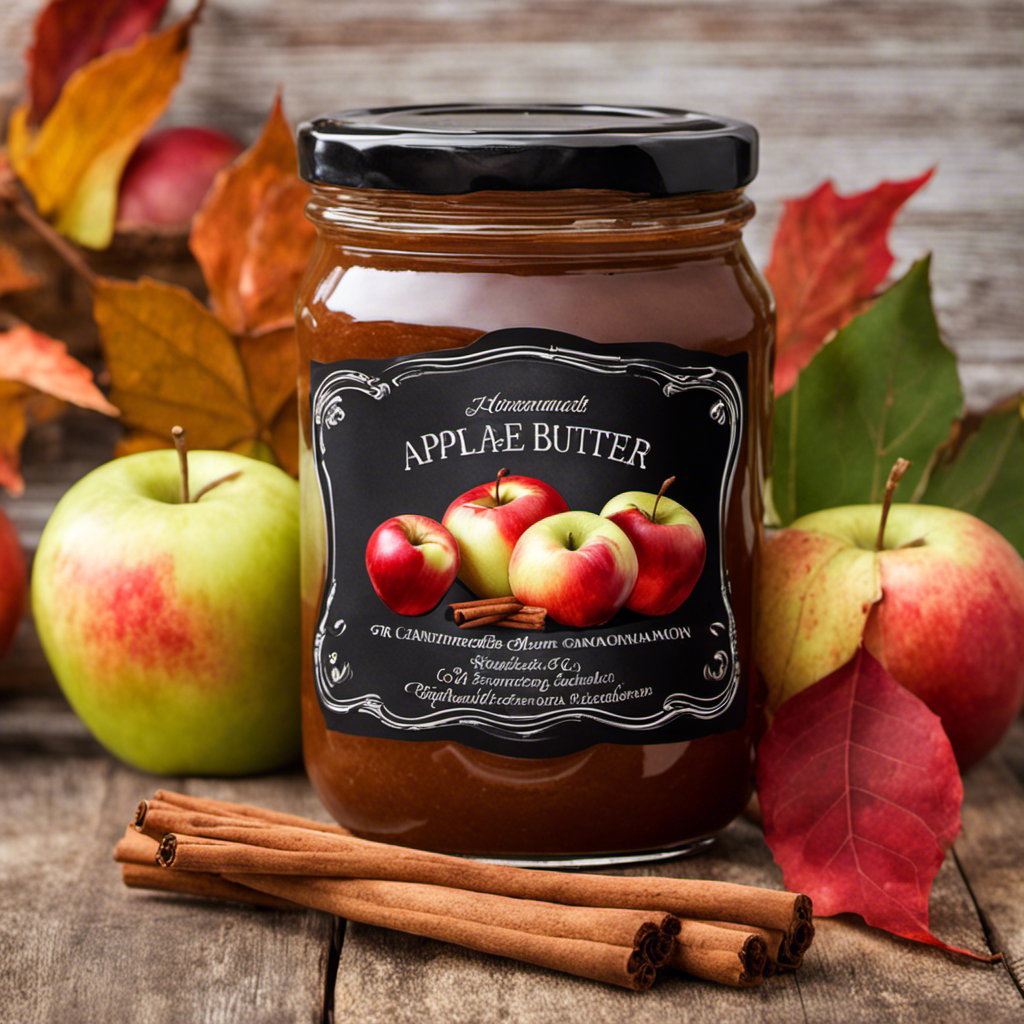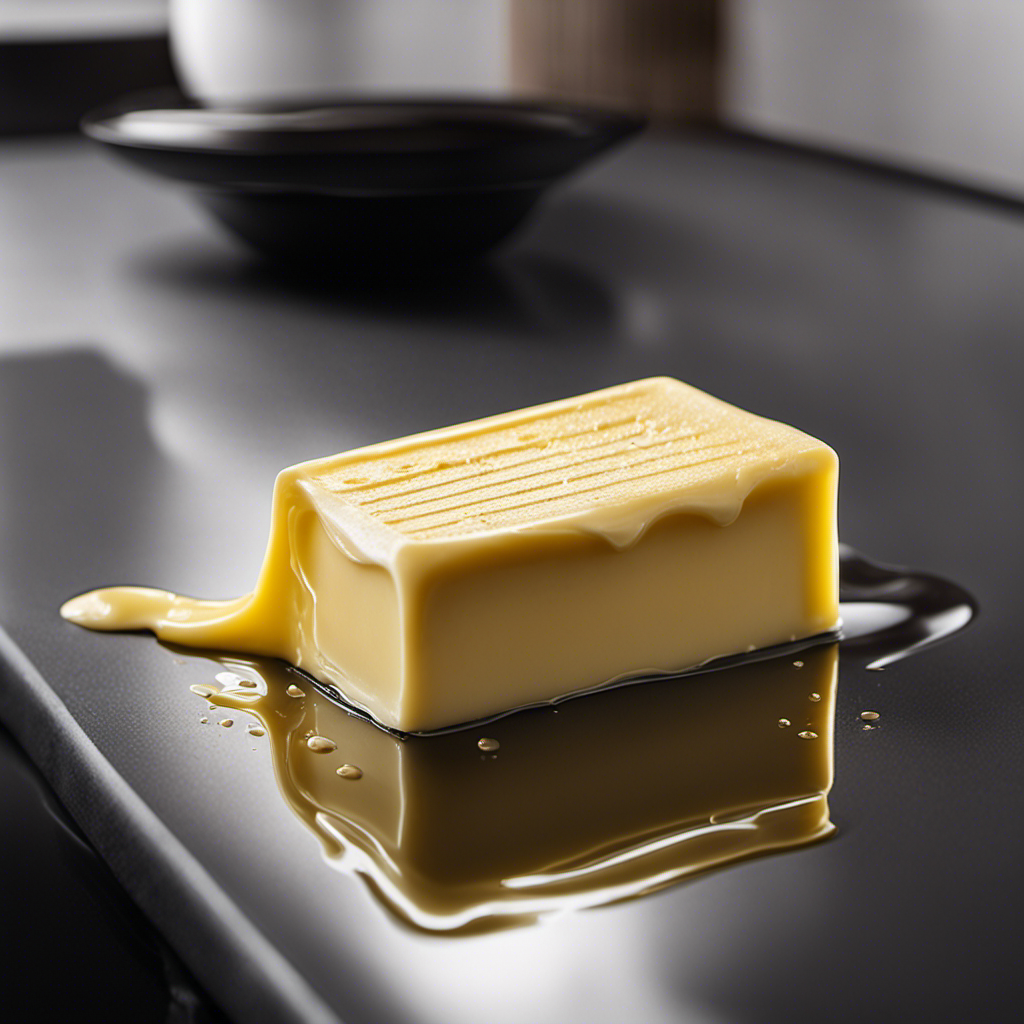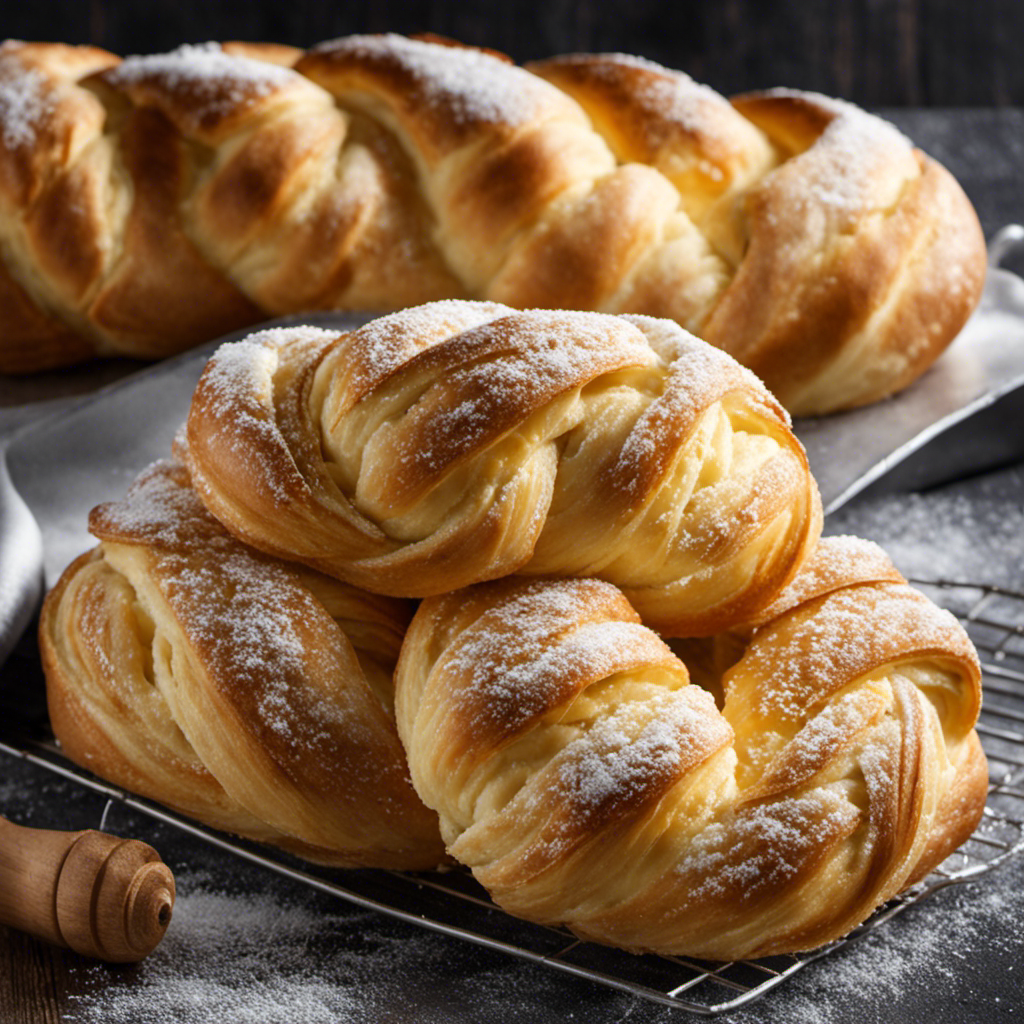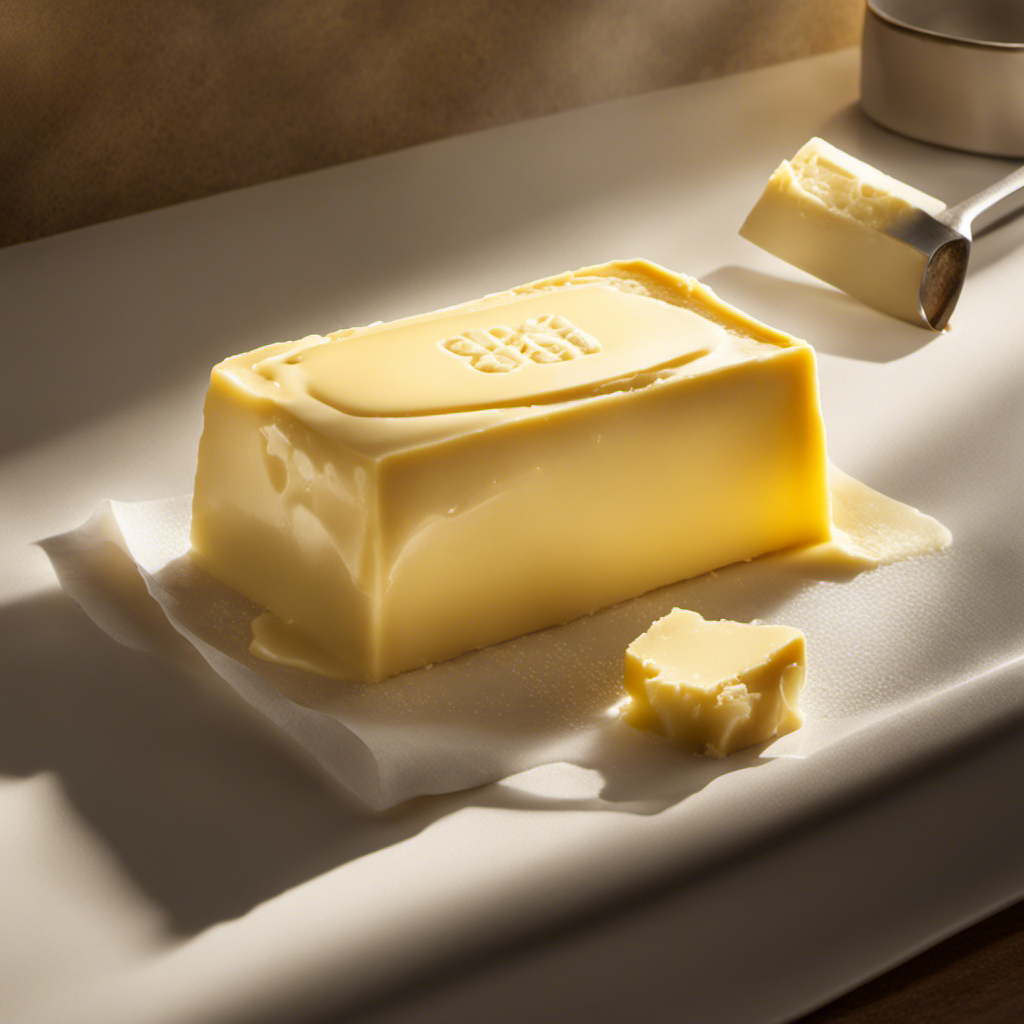Hello, fellow fans of vegan butter!
Have you ever wondered how long your favorite plant-based spread can last? Well, wonder no more! In this informative article, I’ll be diving into the shelf life of vegan butter and the factors that can affect its longevity.
I’ll also share some handy tips on proper storage and how to tell if your vegan butter has gone bad.
So, grab a tub of your favorite alternative and let’s get started on this buttery journey!
Key Takeaways
- Vegan butter typically lasts for 2-3 weeks in the refrigerator.
- Proper storage techniques, such as using an airtight container, help maintain quality and flavor.
- Signs of spoiled vegan butter include off smell, change in texture, discoloration, and bitter taste.
- Refrigeration significantly extends the shelf life of vegan butter.
Shelf Life of Vegan Butter
Vegan butter typically lasts for about 2-3 weeks when stored in the refrigerator. However, several factors can affect its quality and shelf life.
One important factor is the ingredients used in vegan butter. Some ingredients may have a shorter shelf life, causing the butter to spoil more quickly.
It is also essential to consider the storage conditions. Vegan butter should always be stored in an airtight container to prevent contact with air, which can lead to oxidation and spoilage. Additionally, it is crucial to keep the butter away from direct sunlight and high temperatures, as these can accelerate the degradation process.
Factors Affecting Vegan Butter’s Longevity
To ensure your plant-based spread stays fresh, consider factors such as storage temperature and exposure to air. Proper storage of vegan butter is crucial to maintain its quality and extend its longevity. Here are some key factors that can affect the quality of vegan butter:
-
Temperature: Keep your vegan butter in a cool, dry place away from direct sunlight or heat sources.
-
Air Exposure: Seal the container tightly after each use to prevent air from entering and causing oxidation.
-
Contamination: Avoid cross-contamination by using clean utensils or spreading knives when handling vegan butter.
-
Moisture: Moisture can lead to spoilage, so make sure to keep your vegan butter away from high humidity areas.
By considering these factors, you can ensure your vegan butter stays fresh and maintains its quality for a longer period of time.
Now, let’s dive into the proper storage techniques for vegan butter.
Proper Storage of Vegan Butter
One important aspect of maintaining the quality of plant-based spread is ensuring proper storage techniques are followed.
To keep vegan butter fresh and flavorful, there are a few key storage tips to keep in mind.
First, it is important to store vegan butter in an airtight container to prevent exposure to air, which can lead to oxidation and spoilage. Glass containers with tight-fitting lids are ideal for this purpose.
Additionally, it is recommended to store vegan butter in the refrigerator rather than at room temperature, as cooler temperatures help to extend its shelf life.
Lastly, it is important to avoid cross-contamination by using separate utensils when handling vegan butter to prevent the introduction of unwanted bacteria or flavors.
Signs of Spoiled Vegan Butter
Refrigeration helps extend the shelf life of plant-based spread, but it’s important to be aware of signs that indicate spoiled vegan butter. Here are some key indicators to look out for:
- Off smell: If your vegan butter has a rancid or sour odor, it is likely spoiled.
- Change in texture: Spoiled vegan butter may become grainy, lumpy, or separated.
- Discoloration: Any unusual changes in color, such as darkening or mold growth, are signs of spoilage.
- Bitter taste: If your vegan butter tastes unpleasant or has a strong bitter flavor, it is best to discard it.
It is crucial to pay attention to these signs to ensure the safety and quality of your vegan butter. If you notice any of these indications, it’s best to err on the side of caution and replace the product.
Extending the Lifespan of Vegan Butter
If stored properly, you can keep your plant-based spread fresh and usable for a longer period of time. Extending vegan butter’s freshness and preserving its quality can be achieved by following a few simple steps.
First, make sure to store your vegan butter in an airtight container or wrap it tightly in plastic wrap to prevent any air exposure. This will help to maintain its flavor and texture.
Additionally, storing the butter in the refrigerator rather than at room temperature can significantly extend its shelf life.
Lastly, be mindful of cross-contamination by using clean utensils every time you scoop out some butter. By taking these precautions, you can enjoy your vegan butter for an extended period, ensuring its freshness and quality.
Freezing and Thawing Vegan Butter
When it comes to freezing and thawing vegan butter, it’s important to consider the optimal freezing conditions and the shelf life after thawing.
The optimal freezing conditions for vegan butter include storing it in an airtight container, at a temperature of -18°C or below, to maintain its quality and freshness.
After thawing, the shelf life of vegan butter may vary depending on factors such as storage conditions and how it was thawed.
Optimal Freezing Conditions
To keep your vegan butter fresh for longer, make sure you store it in optimal freezing conditions. Here are some key points to consider:
-
Temperature: Set your freezer to a temperature of -18°C (0°F) or lower. This ensures that the butter stays solid and prevents any potential spoilage.
-
Packaging: Use airtight containers or freezer bags to protect the butter from freezer burn and odors from other foods.
-
Labeling: Clearly label the containers with the date of freezing to keep track of the freezing duration and prioritize the use of older batches.
-
Thawing process: When you’re ready to use the butter, transfer it to the refrigerator and allow it to thaw slowly overnight. Avoid thawing at room temperature to maintain its quality.
Shelf Life After Thawing?
After thawing, you should consume the vegan butter within a week to ensure its freshness. The shelf life of dairy-free spreads can vary depending on various factors such as ingredients and storage conditions. However, it is generally recommended to consume vegan butter within a week of thawing it.
This is because the absence of dairy in these spreads can make them more susceptible to spoilage compared to traditional butter. To prolong the shelf life of vegan butter after thawing, it is important to store it properly. The best storage containers for vegan butter are airtight containers or resealable bags. These containers help to maintain the freshness and prevent the spread from absorbing any odors from the refrigerator.
Using Expired Vegan Butter
When it comes to using expired butter, there are a few key points to consider.
Firstly, the safety of expired butter may be a concern for some people, but it’s generally safe to consume if stored properly and within a reasonable time frame.
Secondly, the taste of expired butter may be affected, becoming rancid or off-putting.
Lastly, if you find yourself with expired butter, there are alternative uses for it. You can use it as a moisturizer for dry skin or as a conditioner for your hair.
Safety of Expired Butter
Expired vegan butter should not be consumed due to safety concerns. When vegan butter expires, it can pose health risks if consumed. Here are some safety precautions to consider:
-
Check the expiration date: Always make sure to check the expiration date before using any vegan butter. Expired butter may contain harmful bacteria or toxins that can cause foodborne illnesses.
-
Inspect the texture and smell: If the vegan butter has changed in texture or emits a rancid smell, it is a sign that it has gone bad. Ingesting spoiled butter can lead to digestive issues and other health problems.
-
Store properly: To extend the shelf life of your vegan butter, store it in the refrigerator at the recommended temperature. This will help prevent bacterial growth and maintain its freshness.
-
Consider freezing: If you have excess vegan butter that is nearing its expiration date, freezing it can help prolong its shelf life. Just make sure to thaw it properly before using.
Effects on Taste
Storing vegan butter in the refrigerator can help maintain its freshness and prevent changes in taste. When vegan butter is exposed to higher temperatures, it can soften and lose its texture, resulting in a greasy or oily feel. However, refrigeration can help to keep the vegan butter solid and maintain its desired texture.
This is particularly important when cooking with vegan butter, as the texture can affect the outcome of your dish. The solid texture of refrigerated vegan butter allows for easier measuring and spreading, making it more convenient to use in various recipes.
Alternative Uses for Expired Butter
Now that we’ve discussed the effects of expired butter on taste, let’s explore some alternative uses for expired butter. While consuming expired butter may not be ideal, it doesn’t necessarily mean it has to go to waste. Here are a few creative ways to repurpose expired butter:
- Baking: Expired butter can still be used in baking recipes that require melted butter, such as cookies or cakes.
- Sauces and dressings: Melted expired butter can be incorporated into homemade sauces or dressings to add a rich and creamy flavor.
- Household uses: Expired butter can be used to lubricate squeaky hinges or to polish leather shoes.
- Moisturizer: Surprisingly, expired butter can be used as a moisturizer for dry skin, particularly on rough areas like elbows or heels.
Vegan Butter Alternatives and Their Shelf Life
To keep your vegan butter alternatives fresh, make sure to check the expiration date before using them.
Vegan butter alternatives, also known as vegan butter substitutes, are made from plant-based ingredients instead of animal products. They provide a tasty and cruelty-free option for those who follow a vegan diet or have dairy allergies.
When it comes to their shelf life, it can vary depending on the brand and ingredients used. Generally, vegan butter alternatives can last up to several months if stored properly in the refrigerator.
However, it is important to check the specific expiration date on the packaging to ensure optimal freshness and taste. Using expired vegan butter substitutes may result in a change in flavor or texture, so it’s best to discard them if they are past their expiration date.
Frequently Asked Questions
Can I Use Vegan Butter Past Its Expiration Date?
I wouldn’t recommend using vegan butter past its expiration date. It may affect the taste and quality of your recipes. However, using fresh vegan butter has many benefits, such as being dairy-free and lower in saturated fats.
Are There Any Vegan Butter Alternatives That Have a Longer Shelf Life?
Personally, I’ve often wondered if there are any vegan butter alternatives with a longer shelf life. It’s important to compare vegan butter substitutes to regular butter to find the best option.
Can I Freeze Vegan Butter to Extend Its Lifespan?
Yes, you can freeze vegan butter to extend its lifespan. Freezing helps maintain its freshness and quality. Make sure to wrap it tightly in a freezer-safe container or bag to prevent freezer burn.
How Can I Tell if My Vegan Butter Has Gone Bad?
If my vegan butter has gone bad, I can tell by checking its texture, smell, and taste. If it feels slimy, has a rancid odor, or tastes off, it’s best to discard it.
What Are Some Tips for Properly Storing Vegan Butter to Keep It Fresh for Longer?
Properly storing vegan butter is key to keeping it fresh for longer. Store it in an airtight container in the refrigerator. Some of the best vegan butter brands include Earth Balance, Miyoko’s, and Country Crock Plant Butter.
Conclusion
In conclusion, when it comes to the shelf life of vegan butter, proper storage is key. By keeping it in a cool, dry place and ensuring it is tightly sealed, you can extend its lifespan.
However, it is important to be mindful of signs of spoilage, such as a rancid smell or unusual texture. If your vegan butter does expire, don’t fret!
There are plenty of alternative options available with their own unique shelf lives. So, stay savvy and savor the spread!










